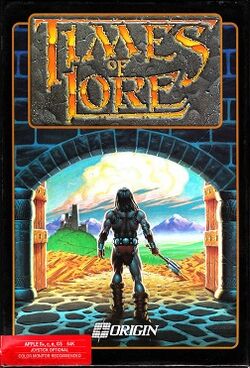Software:Times of Lore
| Times of Lore | |
|---|---|
 | |
| Developer(s) | Origin Systems |
| Publisher(s) | Origin Systems |
| Director(s) | Chris Roberts |
| Producer(s) | Dallas Snell Jeff Hillhouse |
| Designer(s) | Chris Roberts |
| Programmer(s) | Paul C. Isaac Ken Arnold Chris Yates |
| Artist(s) | Denis Loubet Douglas Wike |
| Writer(s) | Paul C. Isaac Brian Roberts Chris Roberts |
| Composer(s) | Herman Miller Martin Galway |
| Platform(s) | Amiga, Amstrad CPC, Apple II, Atari ST, Commodore 64, DOS, NES, ZX Spectrum |
| Release | October 1988 |
| Genre(s) | Action-adventure game, action role-playing game |
| Mode(s) | Single-player |
Times of Lore is a 1988 action role-playing game that was developed and published by Origin Systems for several platforms, including PC, Commodore 64/128, ZX Spectrum, Amstrad CPC, Atari ST, Apple II, NES, and Amiga.
Plot
This article needs an improved plot summary. (February 2018) |
The game's story tells of the kingdom of Albareth whose monarch High King Valwyn has disappeared and the dukes and barons are wrestling for power. Barbarians are threatening to invade, while monsters are pillaging the land. The player must assume the role of one of three heroes, choosing between a barbarian, a knight, and a valkyrie; and unravel the conspiracy and find three magic items.
Gameplay
The game takes place in a very complex world, featuring 13,000 screens of map according to the promotional material. There is no loading during the game, which was an impressive technical accomplishment for such a massive environment.
The Commodore 64 version features high-res overlays for the sprites, a technique that employs two sprites on top of each other one being a low resolution multi-colour sprite the other a high resolution monochrome sprite. Animated water is also used and the game world slowly changes colour between night and day.
It is possible to get to unwinnable situations which require restarting the game, such as killing important characters who would otherwise have given certain quests or objects. Killing random peasants is not as dangerous, as staying the night at the inn will make them forget your trespasses.
There are many objects to be found in the game, including a teleportation scroll, a returning axe à la Mjolnir, and healing potions. There is the hidden city of Treela, in the middle of the map, behind a forest. Serfs will speak of a dragon in the north, which can be found sleeping in his cave on the eastern edge of the northern mountains. Catacombs also exists but if entered, the ghouls inside are unleashed upon the world, making the game much more difficult. In the Apple II version, the dragon is replaced with a giant lurking in the northwest portion of the map.
Development
Times of Lore, developed by Chris Roberts, was originally titled Ultra Realm.[1] According to Roberts, it was inspired by console action-adventures, particularly The Legend of Zelda.[2][3] Roberts stated that "interfaces and design are being affected" by the video game console market and that what "the Japanese market originally demanded were certain constraints which did not affect the depth and quality of a game."[3]
Reception
Scorpia of Computer Gaming World recommended Times of Lore as an introductory computer RPG, noting both dialogue and actions were menu-driven, simplifying the game.[4] Compute! agreed with the recommendation, noting that the game's scale was smaller than the Ultima games' and praising its graphics and sound.[5] The magazine named the game to its list of "nine great games for 1989" as "an excellent introductory-level fantasy role-playing game".[6]
Reviews
- Jeux & Stratégie #56[7]
Legacy
Times of Lore went on to inspire several later titles by Origin Systems.[3] This includes the 1990 title Bad Blood, another action RPG based on the same engine.[2][3] It also inspired the 1990 title Ultima VI, which adopted several elements from Times of Lore, including real-time elements, a constant-scale open world (replacing the unscaled overworld of earlier Ultima games),[3] and an icon-based point & click interface.[8][9] Richard Garriott, in addition to citing it as an influence on Ultima VI,[9] said that Ultima VII was also inspired by Times of Lore.[10] Some have considered the game as a precursor to Diablo and Baldur's Gate.[11]
References
- ↑ "The Stars His Destination: Chris Roberts from Origin to Star Citizen". 2014-09-13. http://www.usgamer.net/articles/chris-roberts-star-citizen-profile.
- ↑ 2.0 2.1 Barton, Matt (2008). Dungeons & Desktops: The History of Computer Role-Playing Games. A K Peters, Ltd.. pp. 181–182, 212. ISBN 978-1-56881-411-7. https://books.google.com/books?id=qPPRBQAAQBAJ&pg=PA182. Retrieved 2010-09-08.
- ↑ 3.0 3.1 3.2 3.3 3.4 Computer Gaming World, issue 68 (February 1990), pages 34 & 38
- ↑ Scorpia (Jan 1989). "Times of Lore". Computer Gaming World: 59–60.
- ↑ Poggiali, Len (March 1989). "Times of Lore". Compute!: pp. 70. https://archive.org/stream/1989-03-compute-magazine/Compute_Issue_106_1989_Mar#page/n71/mode/2up. Retrieved 10 November 2013.
- ↑ Gutman, Dan (July 1989). "Nine for '89". Compute!: pp. 19. https://archive.org/stream/1989-07-compute-magazine/Compute_Issue_110_1989_Jul#page/n19/mode/2up. Retrieved 11 November 2013.
- ↑ "Jeux & stratégie 56". March 1989. https://archive.org/details/jeux-et-strategie-56/page/72/mode/2up.
- ↑ Maher, Jimmy (2017-04-07). "Ultima VI". http://www.filfre.net/2017/04/ultima-vi/.
- ↑ 9.0 9.1 The Official Book of Ultima. 1990. https://archive.org/stream/TheOfficialBookOfUltima/The-Official-Book-of-Ultima#page/n95/mode/2up.
- ↑ Vintage Games: An Insider Look at the History of Grand Theft Auto, Super Mario, and the Most Influential Games of All Time, page 347
- ↑ Times of Lore, Lemon64
External links
- Times of Lore at MobyGames
- Times of Lore at Hall of Light
- Times of Lore at SpectrumComputing.co.uk
- Times of Lore can be played for free in the browser at the Internet Archive
 |


